#aos men 1950s series
Photo

AoS Men~1950s Series (pt. 4)
36 notes
·
View notes
Text
Abridged history of early 20th century Chinese womenswear (part 1: 1890s & 1900s) *improved version

Source here
*I’m fixing and reposting the first two posts of this series because back then I had no idea how Tumblr formatting functioned and they deserve better. I’m keeping the shoddy original versions for archival purposes.
*After some thought I think it makes more sense to group the 1890s and 1900s together.
Other posts in the series:
Part 1: 1890s (original)
Part 2: 1900s & 1910s (original)
Part 3.1: 1920s-silhouette
Part 3.2: 1920s-design details
Part 3.3: 1920s-accessories, hair & makeup
Part 4.1: 1930s-silhouette & design
Part 4.2: 1930s-hair, makeup & accessories
Part 5: 1940s
Part 6.1: 1950s-Hong Kong, Macau, Taiwan & friends
Part 6.2: 1950s-mainland China
Intro & context
In order to understand early 20th century Chinese fashion we have to go back a bit into the past to have some clue about the context. When the Manchus conquered China and established the Qing Dynasty in the mid 17th century, Han Chinese men adopted Manchu style clothing but Han Chinese womenswear remained independent and separate from Manchu womenswear. Han Chinese women retained the habit of wearing a two piece ensemble as the outermost layer, unlike Manchu women, who wore a single floor length robe. I will be only discussing Han Chinese women’s fashion in this series.
In the 19th century, Han Chinese women wore 袄裙 aoqun, a two piece ensemble consisting of a robe and a skirt. The robe had a very low 立领, standing collar. In the second half of the 19th century, the robe in aoqun had a very generous and roomy cut and huge sleeves, a look which reached its peak in the 1860s and 70s. The hem of the robe hit the knees, the length in vogue since the 1870s. The collar of the robe is very low, only providing enough space for one button, likewise in fashion since the 1870s. The robe is closed with 盘扣 pankou, which in this era were always plain with either a bead or fabric knot tip. The robe closes at the side, usually at the right side at the 大襟 dajin, the side closure, however examples of robes with closures on the left also existed. Robes with closures on both the right and left were also a thing, a style called 双襟 shuangjin, double closure. Shuangjin robes were derived from a men’s riding vest, the 巴图鲁坎肩 batulu vest (batulu is Manchu for “warrior”), that could be opened from both sides, and would experience a revival in the 1920s.
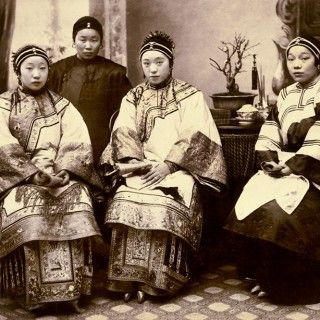
Source here
1870s/80s photograph of a group of women in aoqun, the two skirts on the left are the elaborate mamian style, the one on the right is plain.
In aoqun, the skirt was usually of a style called 马面 mamian, made of two long horizontal pieces of pleated fabric with two flat sections each sewn to a waistband with one flat section overlapping, creating a wrap skirt that once worn around the wearer’s waist, appears to have two unpleated sections, one at the front and one at the back. This skirt was very decorative in the 19th century, full of embroidery, tassels and elaborate trim, sometimes giving the illusion of a separate apron being attached (I’ve seen this weird stereotype that traditional Chinese womenswear has a separate apron at the front this is complete bogus). The robes were likewise heavily decorated around the seams, ceremonial outfits like wedding gowns could be so full of embroidery that the original fabric is hardly to be seen.
The combination of robe and pants, 袄裤 aoku, was also a common way of dressing since approximately the 1800s or 1810s. This combination would become the norm in the 1890s.

Source here
1870s/80s photograph of a woman in a ginormous ao, roomy pants and with bound feet.
Another noteworthy fad was bound feet. The middle of the 19th century was the pinnacle of foot binding and fashionable women had incredibly small feet, dubbed “lotus feet”. This was achieved by wrapping tight foot binding cloth around the feet since childhood and restricting the growth of the feet, I think also breaking a couple bones in the process. Women wore foot binding cloth and baggy stockings underneath their shoes, tied up with garters below the knees. Foot binding is said to severely restrict mobility and cause intense pain; I don’t doubt the pain part but I’m not sure about mobility since I’ve seen plenty of photographs of women with bound feet roaming about the streets.
Not every woman did foot binding though, it depended heavily on region, class and the individual family. For one, Manchu women all had natural feet. For Han women, an account from the 1850s said that in Beijing, every five or six out of ten women did not have bound feet, and that probability is three or four out of ten in the countryside. In the provinces along the southern coast, most women did not bind their feet (this probably has to do with the influence of indigenous cultures in the south, since foot binding was primarily a Han fashion), whereas in the northwest almost every woman had bound feet. By the way, I really don’t like how articles on foot binding describe it in the most sensational way possible, why is it so hard to approach history with peace of mind? And it pisses me off that all the articles containing 1890s photographs only talk about the foot binding as if there is nothing more of value in portraits of whole ass women.
Anyway, if you are interested in learning more about foot binding, check out Cinderella‘s Sisters: A Revisionist History of Footbinding by Dorothy Ko, recommended by @thefeastandthefast . Or just anything written by Dorothy Ko tbh.
Silhouette
In the 1890s, the cut of the aoqun began to become more slender and form fitting, commonly believed to be a result of westernization. But I think it’s also because the wide sleeve look has also been in fashion for quite a while now (some 80 years or so) and people were getting tired of it. The robe inherited the knee length hem from the 1880s but was less baggy and took on a more straight cut silhouette. The collar remained quite low until the end of the decade. Pants were overwhelmingly more popular than skirts in the 1890s, I speculate this may be due to a rising interest in feminism and women wanting more mobility, but aoku was also very popular in the 1870s and 80s in general so it may have also just carried over. The pants were still ankle length and straight cut but less roomy than earlier 19th century models. Overall the 1890s just looks like a shrunken and simplified version of the 1880s.

Source here
The aoku as of the 1890s.
By the second half of the 1900s, the collar began to rise, becoming medium height. This was kind of reminiscent of late 18th century Han women’s collars I mentioned in this post on Chinese standing collars. The robe and pants shrunk further, becoming quite tight fitting. The robe was still around knee length. The pants were especially tight and could be considered skinny. Foot binding became less common and many women had natural sized feet. However, since foot binding is something that begins in the childhood, the fact that many women without bound feet appeared in the 1900s meant that many parents started to reject food binding in the 1880s and 90s.

Source here
Ca. 1907 photograph of a group of women, possibly students, in tight fitting aoku.
Design details
The 1890s saw the mass disappearing of wide, embroidered trims around the seams, popular throughout the 19th century. The use of multiple rows of binding/trim from the 1870s and 80s was continued, albeit in a much more minimalistic and geometric way. I’ve seen a lot of plain white ao finished with multiple rows of black binding of different widths, it’s mighty avant-garde and elegant. Because clothes of the era were still constructed in the older Chinese method, they had a seam down the middle of the sleeves used to extend the length of the sleeves; this seam could be bound and decorated but it was not compulsory. Actual embroidery on the robe and skirt/pants was rare, if not non-existent; completely plain fabric was the norm. The ao of this era commonly had a 厂字襟 (厂 shaped closure), where the front placket is held up by one or two buttons and then closed by more buttons down the side seam. This style of closure was first popularized for Han women’s clothing in the 1800s and 1810s, before that Han women’s clothing closures were a straight line from the collar to the armpit. The pankou used to close the ao of this period became a lot more elaborate and the main source of decoration; I have a whole ass post on them here. A general air of simplicity, comfort and proportionality dominated the fashion of this era. In the mid 18th century, Han women’s robes started having folded cuffs (possibly borrowed from Manchu court dress), called 挽袖 wanxiu, and these became fake and represented by a piece of trimming in the 1850s. By the 1890s this design feature largely disappeared, leaving the sleeve edges either plain or simply bound.

Source here
Three women in aoku, late 1890s. I looooove the look on the far left, I will probably make it some day.
Going into the 1900s, the geometric trims became more simplified and austere, while the pankou became increasingly ornamental.
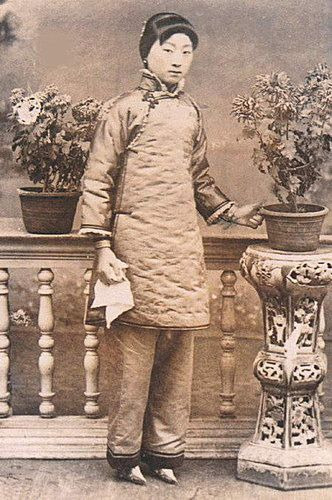
Source here
Late 1900s photograph. The robe is trimmed with fur and thin, geometric binding, and closed by very ornamental pankou.
Hair & Makeup
There were no significant changes in hairstyling in the 1890s, fashionable women would wear existing 1880s hairstyles but style them with bangs. A common style I’ve seen in photographs was long hair pulled back into either one big bun at the back or two smaller ones at the sides. The short bangs were usually very neat, precisely cut and sat closely to the forehead. Elastics did not exist, so Chinese women used strings and hairpins to tie their hair together. Hairpins of this era were usually very thick and sturdy, a single one was enough to hold all your hair into a bun. It was popular to use flowers and/or pearls to form a ring of decorations around a bun.
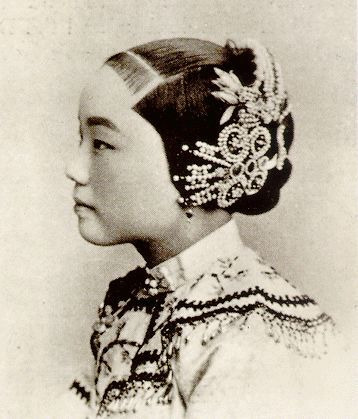
Source here
Common 1890s hairstyle, for most people the decorations weren’t so elaborate.
A popular headpiece was this thin headband adorned with pearls worn at the place where bangs should be, although that has been around since the 1870s as well.

Source here
Ca. late 1890s. Some women wearing the pearl headband.
Around 1905 the bangs began to grow in length but still weren’t long enough to cover the eyebrows. They were longer at the sides and shorter in the middle, creating this volume and curve at the forehead.
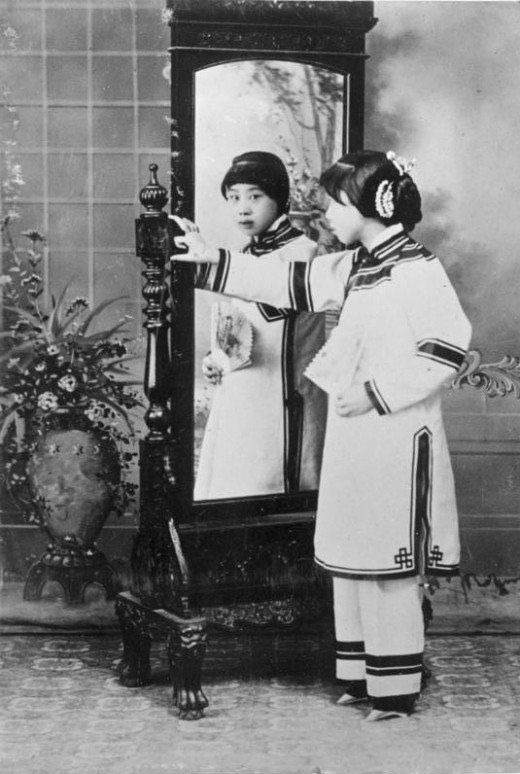
Source here
Photograph ca. 1905. Long bangs.
By the end of the decade these evolved into a being with a will of its own. Long hair tied into braids or low buns became fashionable instead of tight, high buns.

Source here
Calendar painting from 1911.
Fashionable women in the 1890s wore little to no makeup, because of the influence of female university students who were usually without makeup. In the 1870s and 80s, thick makeup was more common and was a trend popularized by sex workers in Shanghai, thus becoming increasingly considered indecent in the 1890s. I find this quite problematic cause respectability politics suck and there’s nothing wrong with wearing fashion trends invented by sex workers. All the straight male writers of the 1890s and 1900s praising female students for being “pure” and ”hygienic” in contrast to the supposedly nasty sex workers make me cringe to my core, it’s just pitting women against each other and setting us up for “I’m not like other girls” in my opinion.
The common makeup look includes white power, lipstick and blush. The lipstick shape was usually a tad smaller to the actual lips and blush was applied in large areas toward the outside of the face.
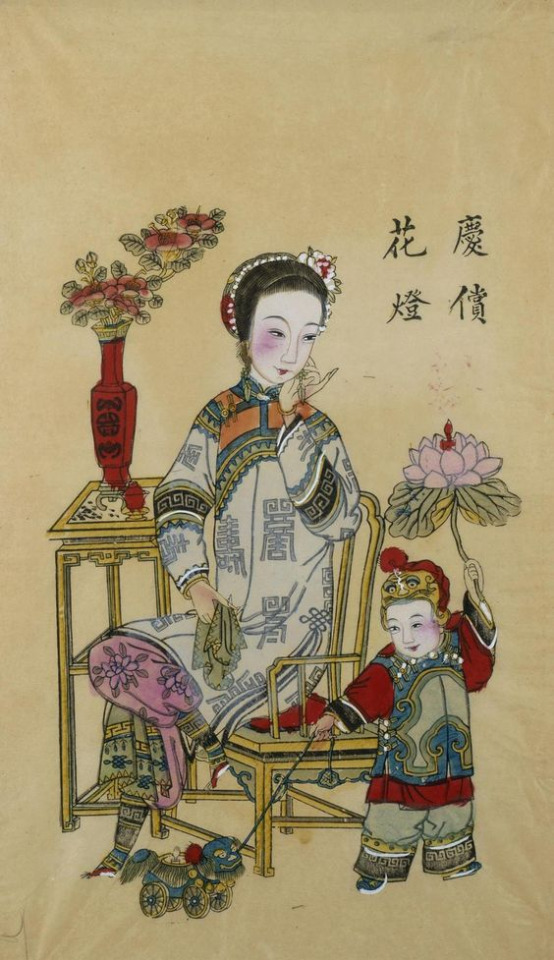
Source here
Standard 1890s and 1900s hair and makeup look. This drawing is probably from around 1902, it’s a bit more festive folk art than fashion plate so take the patterns with a dash of salt.
Undergarments
Unfortunately I don’t have many pictures for undergarments of the era but I can describe them to you. Since women commonly wore pants, they would usually wear another layer of pants (could be considered drawers) underneath that was of a similar construction but plain and easy to launder. Panties and such didn’t exist so drawers were the innermost layer, enough to protect women’s private parts. Likewise for the robe, another plainer, sturdier version would be worn underneath. In the mid 1900s, as the sleeves of the outer robe began to shorten, the undershirt became more form fitting at the wrists and could serve a decorative function.
Chinese women in the 19th century bound their breasts with long strips of fabric to achieve the flat look. I’m not exactly sure how this is done but basically you wrap fabric tightly around your chest until the boobies are concealed. A famous undergarment of the Qing Dynasty was the 肚兜 dudou, which was actually unisex. The female only version was called 抹胸 moxiong, 袜肚 wadu or 袜腹 wafu, the latter two are etymologically similar to earlier words for “corset” or “a pair of bodies”. However, unlike what many later 20th century artists would like you to believe, wearing only dudou on the upper body was not legit underwear for grown up women, as it was usually worn in conjunction with breast binders as an extra layer of warmth. It was also worn very tightly around the breasts and waist, not tied loosely like in paintings or period dramas nowadays.
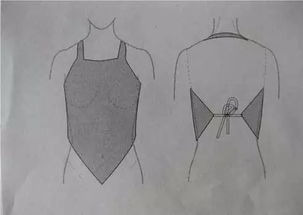
Source here
Dudou diagram.
Shoes
Women began campaigning against bound feet in this period and many drawings depicted women with natural feet. However, if a woman had her feet bound since childhood it’s difficult for them to return to their natural size, so some women who were born in previous decades would still have very small feet, even if they began to reject it at this time. Women’s shoes of Western construction weren’t yet so common so most women wore Chinese style shoes, which were commonly made of fabric and had a slightly upward pointing toe. Women with bound feet would use a long piece of ribbon/cloth to wrap their feet (to maintain the shape) and wear small fabric pumps with a white sole. These could be flat or have a teeny tiny bit of wedge heel, called 弓鞋 gong xie, bow shoes. Women without bound feet would wear normal sized pumps, likewise of fabric, with slightly upward pointing toes and a thick white sole. Embroidery on shoes was a huge thing in the 19th century and before but by the 1890s it started to disappear as well, and shoes in the 1890s were commonly plain. In the 1900s, Western leather shoes were increasingly popularized, but it wasn’t until the early 1910s that this popularity reached its height.
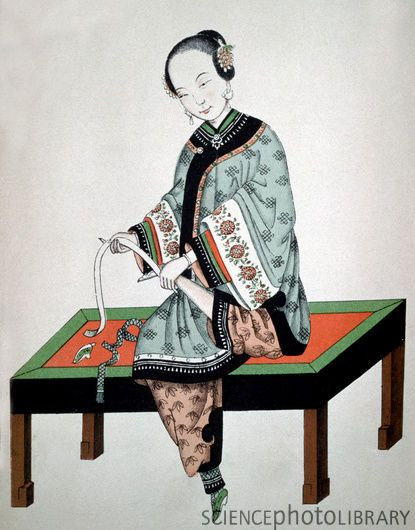
Source here
Foot binding cloth.

Source here
Shoes for bound feet.

Source here
Woman with natural feet wearing Chinese style pumps. Western style knit stockings were becoming popularized in the 1880s for women with natural feet as well.
Some editing afterthoughts
I’ve been looking more into 18th and 19th century Chinese fashion lately and I realized I held some deep rooted misconceptions about the Qing Dynasty. For some reason I always considered the 1870s and 80s look with the elaborate, big robes conservative or backwards, which is really not fair. Chinese women’s fashion was revolutionized in the beginning of the 19th century, going from the flowy, slender robes of the 18th century to stiffer, more structured robes with flared sleeves. Styles also differed dramatically from decade to decade, it’s just not very well studied and there’s a stigma around Qing Dynasty fashion so people don’t get into it as much. Because Han women were allowed to continue wearing Han style clothing into the Qing Dynasty, a lot of 18th century reproduction ensembles nowadays get mistakenly labelled as Ming style hanfu, which really isn’t helping... I was definitely not alone in this though, the perception of Qing Dynasty Han women’s fashion most people nowadays have is: in the first couple years Han women were allowed to wear Ming style hanfu, but then bam the late 19th century look was forced upon everyone. This view is super not nuanced and false on almost every level, but it is extremely widespread and I don’t blame you at all if you also think like this, this was me just two months ago too... A wise woman (I mean Karolina Zebrowska) once said that everything in fashion history happens gradually, which is also extremely true for Chinese fashion history.
I’ve really started to question what modernity in fashion means because the elaborate 19th century Chinese look that white people back then considered the epitome of conservative Chinese clothing was actually new and exciting in the beginning of the 19th century. I can’t help but wonder if this view that Chinese clothing as of the 1870s and 80s was symbolic of Chinese culture’s “backwardness” and “stagnation” was a product of colonization and white imperialists’ efforts to demonize Chinese society and take things out of context. I would prefer to say that Chinese fashion westernized a lot during the 1890s and 1900s but not necessarily modernized because what is modernity. Fashions change and that is the most normal thing on the planet.
If you read what white historians or politicians wrote in the late 19th/early 20th century about Chinese fashion or culture (which I highly recommend you don’t, that shit is detrimental to your mental health), it becomes obvious that the majority of them have no clue what Chinese fashion looked like before the 19th century and how we got to what we had in the 19th century in the first place, so they just assumed that Chinese fashion always looked like that and that we haven’t progressed as a culture in hundreds of years lmao. Bullshit pseudo-Darwinism at its finest. Oh or if you look up 18th century European Orientalist paintings depicting imaginary Chinese characters, the clothes they wore and the hairstyles they had were so far off from what actual 18th century Chinese fashion looked like to the point they felt racist and were uncomfortable to look at. I stumbled across so many of them when looking for 18th century Chinese painting and every time I see one it almost gives me a stroke. So I think it’s really important to acknowledge that Han Chinese fashion of the 18th century is a valid field of study.
In my original 1890s post I said that the elaborate embroidery and trimmings started to appear on Han women’s fashion around this time because of Manchu influence, I take that back because I’ve realized it’s a whack claim. I’ll explain it more when I make some posts on the 19th century later.
Reworked part 2 is coming soon as well :)))
#1890s#1900s#19th century#historic fashion#qing dynasty#vintage fashion#vintage hair#vintage shoes#chinese fashion#chinese history#abridged history of early 20th century chinese womenswear#清汉女装#edwardian fashion
395 notes
·
View notes
Text
O meme mais rapido da Terra
!‘Terminator nunca marchará nos Champs-Elysees’:
Ministro da defesa francês contrário aos ‘robôs letais’ em combate
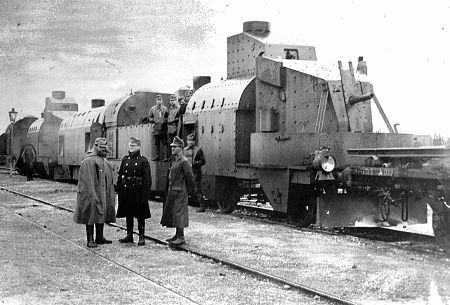
Aos Memeógrafos!
Memeadores, memeoreiros, memeoristas, memeificadores, memeistas, memeoteiros, outeiras, e memeistificadores!
O Papel das Ferrovias no Combate (trecho)Por Edwin A. Pratt, Autor de The Rise of Rail-Power in War and Conquest.
A Teoria da "Guerra Através dos Horários da Ferrovia", de A.J.P. Taylor
Ferrovias e a mobilização para guerra em 1914
A Iª Guerra Mundial não teria sido a mesma sem as ferrovias
A Teoria dos Horários de Ferrovia, de AJP TAYLOR (como ponto de partida para a Iª Guerra Mundial)
O Papel das Ferrovias da Iª Guerra Mundial
Trens a Vapor Eram as Superarmas do Século 19
No pasarán! (passarin?)
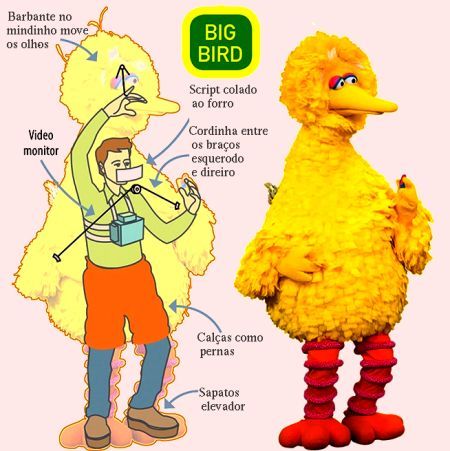
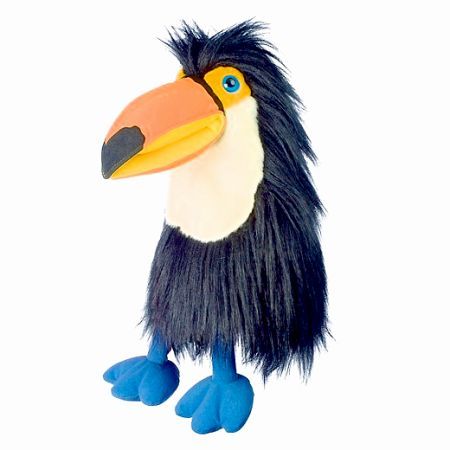
Est’ce cassava?
Holberg knew that the satirical content of the novel would cause an uproar in Denmark-Norway, so the book was first published in Germany, in Latin. He thus got a broader audience than he would have gotten in his homeland. The novel made him widely acclaimed across Europe. Danish, German, French, and Dutch translations were also published in 1741.
The book is significant in the history of science fiction, being one of the first science-fiction novels in history along with:
Johannes Kepler's Somnium (The Dream, 1634),
Cyrano de Bergerac's Comical History of the States and Empires of the Moon (1656),

Jonathan Swift's Gulliver's Travels (1726), and
Voltaire's Micromégas (1752).
The Road to Science Fiction, Volume 1: From Gilgamesh to Wells.
https://en.wikipedia.org/wiki/Niels_Klim%27s_Underground_Travels#Influence
https://gl.wikipedia.org/wiki/A_viaxe_subterr%C3%A1nea_de_Niels_Klim
https://en.wikipedia.org/wiki/Golden_Age_of_Science_Fiction#Prominent_Golden_Age_authors
Prominent Golden Age authors
A number of influential science fiction authors emerged in the early Golden Age (1938–1946), ...
Asimov said that "The dropping of the atom bomb in 1945 made science fiction respectable" to the general public.[13] He recalled in 1969 "I'll never forget the shock that rumbled through the entire world of science fiction fandom when ... Heinlein broke the 'slicks' barrier by having an undiluted science fiction story of his published in The large, mainstream companies' entry into the science fiction book market around 1950 was similar to how they published crime fiction during World War II; authors no longer could only publish through magazines.[5] Asimov said, however, that[13]
Space opera examples
y así nos gusta
a "hacky, grinding, stinking, outworn, spaceship yarn".[8]
Short stories
collection of stories (1939-1962)[20]
Hal Clement, " James Blish, "" (1952), (Book 3 of [NB 1]
Tom Godwin, " Isaac Asimov, " Poul Anderson, "Kyrie" (1968)[21]
Frederik Pohl, "Day Million" (1971)[21]
Larry Niven, " and " Greg Bear, "Tangents" (1986)[21]
Geoffrey A. Landis, "A Walk in the Sun" (1991)[25]
Vernor Vinge, "Fast Times at Fairmont High" (2001)[25]
Novels
Aldous Huxley, George Orwell, Robert A. Heinlein, (1952)
Hal Clement, Harry Martinson, (1953)
Fred Hoyle, James Blish, Jack Vance, John Wyndham, Stanisław Lem, Arthur C. Clarke, (1968), The Jagged Orbit
Michael Crichton, Poul Anderson, Tau Zero (1970)[23]
James Gunn, Bob Shaw, (1975)[24]
The Two Faces of Tomorrow
Robert L. Forward, Steven Barnes and (1982)[26]
Michael Crichton, Robert Silverberg (editor), Kim Stanley Robinson, The Green Mars
Ben Bova, series (1992–2009)
Nancy Kress, Linda Nagata, The Nanotech Succession (1995–1998)
Greg Egan, Alastair Reynolds, Paul J. McAuley, (2008)
James S. A. Corey, (2011)
Neal Stephenson,
Films
Frau im Mond (1929)
(1968)[31]
(1970)[32]
(1971)
Silent Running (1972)[31]
(1972)[31]
Dark Star (1974)[31]
Blade Runner (1982)[33]
(1984) – sequel to 2001
(1997)[31]
The Man from Earth (2007)
(2009)[31]
Robot & Frank (2012)
Europa Report (2013)
(2014)
Ex Machina (2014)[34]
Television
Men into Space (1959–1960)
Star Cops (1987)
(2004–2008)
(2015–present)
Anime / Manga
Mobile Suit Gundam (1979)
2001 Nights (1984, 1986)
They Were Eleven (1986)
Royal Space Force: The Wings of Honnêamise (1987)
Patlabor 2: The Movie (1993)
(1999, 2004)
Pale Cocoon (2006)
Dennō Coil (2007)
Rocket Girls (2007)
(2007–present)
Eden of the East (2009)
Visual novels
(1994)
YU-NO: A Girl Who Chants Love at the Bound of this World (1996)
0 notes
Photo
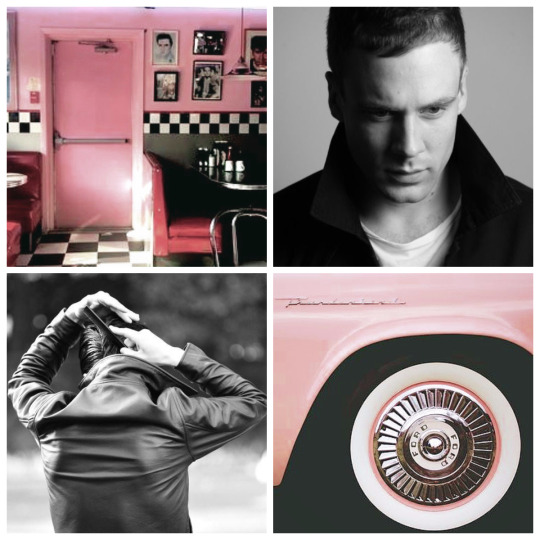
AoS Men~1950s Series (pt. 2)
#earth vs space#team earth aos#lance hunter#aos men 1950s series#luck of the draw#maggie's moodboards
35 notes
·
View notes
Photo

AoS Men~1950s Series (pt. 6)
#earth vs space#team earth aos#robbie reyes#aos men 1950s series#luck of the draw#maggie's moodboards
34 notes
·
View notes
Photo

AoS Men~1950s Series (pt. 3)
#earth vs space#team earth aos#Lincoln Campbell#aos men 1950s series#luck of the draw#maggie's moodboards
34 notes
·
View notes
Photo

AoS Men~1950s Series (pt. 1)
for @oh-my-hades 💕
#earth vs space#team earth aos#phil coulson#aos men 1950s series#luck of the draw#maggie's moodboards
25 notes
·
View notes
Photo

AoS Men~1950s Series (pt. 5)
#earth vs space#team earth aos#Alphonso Mackenzie#Mack#aos men 1950s series#luck of the draw#maggie's moodboards
21 notes
·
View notes
Text
AoS Men~1950s Series Master Post
Once again for the ever amazing and incredibly talented @oh-my-hades for Luck of the Draw! Thank you so much for suggesting this, I had a blast!
❤️ Coulson
💖 Hunter
💚 Lincoln
💙 Fitz
💜 Mack
🖤 Robbie
13 notes
·
View notes